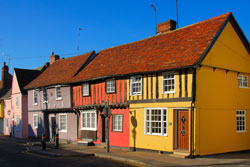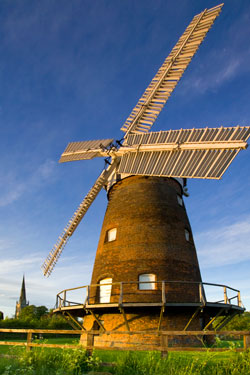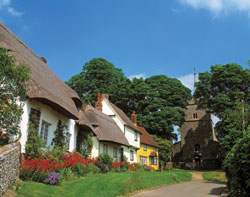Discover the collection of hidden gems in the capital’s commuter-belt county of Essex.
 |
| Colourful cottages in the streets of Saffron Walden |
Essex, while hugging the nation’s capital on its eastern edges, nevertheless remains largely a ‘hidden’ county for visitors. And yet, much of the county is green and pleasant, full of beautiful countryside and historic towns and villages. It’s the ancient kingdom of the East Saxons and, in an even earlier age, of the Trinovantes, an Iron Age tribe who grew so prosperous in the Late Iron Age that their wealth helped tempt the Romans to invade. It’s a place of which the observations made in 1902 by a writer from Country Life magazine still hold true, “The county of Essex is not the least famous of the shires of England for its old domestic architecture, or for the beautiful and fragrant gardens that are the adornment of its mansions.”
At least most people have heard of Colchester, England’s oldest town, once the capital of the Trinovantes, and packed with history and interest. But some of the county’s best-kept secrets are hidden in its north-western corner, in the valleys of rolling hills and woodlands to the south of the small market town of Saffron Walden. The first half of the town’s name refers to an industry that thrived here 500 years ago, based on the cultivation of the saffron crocus, extracts from which were used to season food, to produce yellow dye and medicines and even as an aphrodisiac.
Today visitors can enjoy the legacy of this productive past: a large number of well-preserved historic buildings dating from the medieval period onwards. The handsome market square, crumbling castle ruins and almost incongruously substantial church of St Mary the Virgin – the largest parish church in Essex – are the grander sights, but the town’s great charm lies in its collection of small, independent shops, fine pubs and restaurants.
At its western edge, Saffron Walden runs up against the grounds of one of south-east England’s more distinguished country houses: Audley End, a sumptuous Jacobean mansion surrounded by extensive landscaped grounds. It was built on the site of a 12th-century Benedictine Priory, on land given by Henry VIII to his Lord Chancellor Sir Thomas Audley, following the Dissolution of the Monasteries. In the late 17th century it was a royal palace, purchased by Charles II because of its handy proximity to Newmarket Racecourse.
Today, Audley End remains a place where it’s easy to drift into fantasies about an idle aristocratic lifestyle as you gaze out of the saloon window across the lawns that slope gently from the house’s west front to the River Cam. Other highlights include the restored Victorian kitchen garden, with rows of fruit trees, vegetables and herbs alongside glasshouses of exotic fruit trees and vines; and the elegant Tea House Bridge, built in 1780 and still as peaceful a place to sit and look out over the river and gardens as it would have been during long afternoons of card-playing and sunshine in Regency England.
 |
| Thaxted Post Mill, built by a local farmer |
About five miles south-east of here is the proud little town of Thaxted. In the pre-industrial age this was an important centre for the manufacture of cutlery and its Guild of Cutlers built the superb 15th-century Guildhall, which now houses a small museum. It’s one of the most beguiling medieval buildings I’ve ever seen, but just one of several fine examples in the village, like the sprawling, bending half-timbered ‘Dick Turpin’s cottage’ just around the corner in Stony Lane (the highwayman was born in the village of Hempstead, a few miles farther north). This is also one of a number of hilly Essex settlements where a windmill has survived into the modern age. John Webb’s windmill, built in 1804, is in full working order, looks picture perfect, and is open to the public at weekends and Bank Holidays between Easter and autumn.
Drive westward cross-country from Thaxted and the road twists, dips and rises through the delightful countryside around the town of Braintree which hides some more distinguished villages. These include Great Bardfield, home in the 1950s to a group of influential artists, including Edward Bawden and Eric Ravilious, where a white-washed, thatched 16th-century cottage in the high street houses an entertaining small museum.
But arguably the most spectacular village is Finchingfield, where an extensive village green is split by a duck-filled stretch of river and overlooked by another fine windmill (now a private house). Finchingfield Antiques Centre, sandwiched between a tea room and the Fox Inn, is packed with intriguing furniture, art and other treasures.
A little farther west and the buildings of another very pretty village, Castle Hedingham, are laid out on the hillside below the imposing 850-year-old walls of Hedingham Castle. Although mature trees now partly shield it from view, it’s easy to see how the the huge 12th-century keep would have dominated the landscape when built, by the Norman knight Aubrey de Vere, in about 1140.
You can get a good idea of what life was like here by exploring the interior, reconstructed after an accidental fire destroyed the medieval timbers during the First World War. Climb to the top floor for panoramic views of Essex.
While in this part of the county you should also take the opportunity to visit the garden at Spencers, a small Georgian country house near the village of Great Yeldham. It includes a breathtaking walled flower and vegetable garden, complete with 18th-century greenhouse, atmospheric woodland gardens, and graceful parkland. If you can, time your visit to coincide with the annual midsummer music jazz festival each June when picnickers gather in the gardens for alfresco dining and music.
There are more “fragrant gardens” to be enjoyed farther south at Marks Hall. They occupy part of an ancient estate and incorporate the remnants of a medieval deer park, the ornamental lakes and 18th-century walled garden of the mansion that stood here until demolition in 1950, a beautifully developing arboretum of trees from around the world, and an affecting memorial to the bombing squadrons who flew from nearby Earl’s Colne airfield during the Second World War. But nothing here excited me as much as the worn magnificence of the Honywood Oak, thought to be 700 years old, one of a few ancient oaks that survive from the medieval park.
 |
| The village of Wendens Ambo |
Finally, if you really want to surprise someone who doesn’t know Essex very well, point out that the country has more than 350 miles of coastline. One of the most evocative places to visit is the pleasant town of Maldon, on the estuary of the River Blackwater, supposedly the site of the Battle of Maldon in 991, when heroic Saxon defenders were routed by invading Danish Vikings. Today it’s just a very pleasant place to spend the day. Stand on the quay here and you’ll almost certainly see at least one of the few surviving iconic Thames barges, stout but beautiful sailing boats, more than 2,000 of which were in operation carrying goods between London and the ports of south-east England 100 years ago. They’re now mostly used for tourist trips but form a tangible connection to the past and a reminder of the way that the county’s inhabitants still excel, as they always have, when it comes to mixing business with pleasure.
Discover our editor’s favourite places to visit in Essex!
Learn more about our kings and queens, castles and cathedrals, countryside and coastline in every issue of BRITAIN magazine!






 © 2024
© 2024